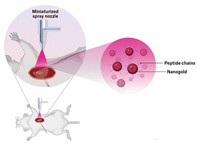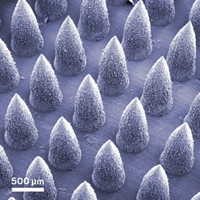Advertisement
Grab your lab coat. Let's get started
Welcome!
Welcome!
Create an account below to get 6 C&EN articles per month, receive newsletters and more - all free.
It seems this is your first time logging in online. Please enter the following information to continue.
As an ACS member you automatically get access to this site. All we need is few more details to create your reading experience.
Not you? Sign in with a different account.
Not you? Sign in with a different account.
ERROR 1
ERROR 1
ERROR 2
ERROR 2
ERROR 2
ERROR 2
ERROR 2
Password and Confirm password must match.
If you have an ACS member number, please enter it here so we can link this account to your membership. (optional)
ERROR 2
ACS values your privacy. By submitting your information, you are gaining access to C&EN and subscribing to our weekly newsletter. We use the information you provide to make your reading experience better, and we will never sell your data to third party members.
Pharmaceuticals
Dissolving Disks Deliver Drugs To The Eye
Drug Delivery: A water-soluble polymer wafer could offer a better alternative to medicated eyedrops
by Katherine Bourzac
February 5, 2015

Researchers have developed a biodegradable polymer wafer designed to dissolve in the eye to release safe, sustained doses of a drug (ACS Nano 2015, DOI: 10.1021/nn506599f). Tested in mice, the wafers delivered a drug more effectively than eyedrops did.
Although the eyes are easily accessible, delivering steady, nontoxic concentrations of drugs to them is a difficult problem, says Stephen C. Pflugfelder, an ophthalmologist at Baylor College of Medicine, in Houston. As a patient blinks, eyedrops are rapidly cleared through the tear ducts into the nasal passages. To compensate for this, drugmakers formulate eyedrops that treat glaucoma, injuries, and other conditions to have very high drug concentrations. These high drug levels can increase the chances of side effects.
Pflugfelder collaborated with Ghanashyam Acharya, a chemist at Baylor, to come up with a better delivery method. Other groups have developed drug-releasing contact lenses, but these are designed to be replaced on a daily basis. Also, they often are made of polymers that irritate an already inflamed eye, Acharya says.
The new design is based on water-soluble polymers that dissolve over time and contain nanosized reservoirs of the drug. The researchers make them by pouring water-based polymer solutions onto a disk-shaped stamp and baking them to remove water. This leaves a 2-mm-wide, 100-µm-thick solid polymer disk that is patterned with drug reservoirs 500 nm in diameter and 500-nm deep.
They evaluated wafers made of four different polymers used in over-the-counter drops that treat dry eye. They found that polyvinyl alcohol had no ill effects when tested on the corneas of mice.
Next, the researchers tested drug-filled polyvinyl alcohol wafers on mice with eye injuries. They focused on antiangiogenic drugs that help prevent the growth of blood vessels on the cornea after a burn or cut. The new blood vessels help prevent infection and promote healing, but they can occlude vision. So it’s critical to keep a high dose of antiangiogenic drugs in the injured eye until it’s fully healed, or patients may lose their sight.
Wafers carrying the drug axitinib had strong therapeutic effects. The researchers compared mice treated with one wafer per day for 10 days to mice treated with eyedrops. Although the daily dose of drug in the eyedrops was twice that in the wafer, animals treated with wafers showed half the volume of new blood vessels in their corneas. Mice treated with the wafers also showed lower levels of gene expression of eight factors that promote blood vessel growth.
The most appealing aspect of the wafers is that they dissolve away, says Dean Ho, a bioengineer at the University of California, Los Angeles, who has also worked on drug delivery to the eye. There would be no need for a patient to remember to remove a lens to prevent bacterial infection.
Next, Ho says, he’d like to see broader safety tests to establish that the wafers are truly nontoxic. Acharya says the Baylor group is currently working toward clinical tests of wafers for other eye diseases and could begin clinical trials by the end of this year.





Join the conversation
Contact the reporter
Submit a Letter to the Editor for publication
Engage with us on Twitter